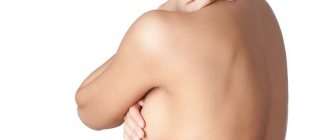Difficulties with breastfeeding may occur if
- you need to go to work, study or run errands;
- the child is premature or has diseases that prevent sucking;
- the breast is hard and full - it is difficult for the baby to suck;
- it hurts to feed because of cracked nipples;
- the mammary gland is inflamed (mastitis);
- you have been temporarily prescribed the necessary medications; they are contraindicated while breastfeeding;
In all these cases, pumping helps maintain or establish breastfeeding.
How often should I pump?
To maintain or increase lactation, express regularly. The more often you empty your breasts, the more milk you will produce. It is formed “on request”. This is regulated by 2 hormones: prolactin and oxytocin.
The first one “releases the plan” to the mammary gland for milk, depending on how much was needed last time. Oxytocin allows stored milk to flow from the breast in response to nipple traction - this is called the oxytocin reflex.
How to signal to your body how much nutrition you need to create for your child?
If you don't have enough milk, pump every hour for the first few days. Then you need to express as often as the baby would like to eat: usually every 2-3 hours. This regimen is also suitable for maintaining lactation. At night you can take a break for 4-6 hours.
How long can I use expressed milk? Look at the table. It refers to milk collected in a sterile container. Write the date of collection on the container.
Basic principles
For a normal volume of secretion, the glands should be emptied every 3-4 hours. If newborns need milk very often in the first months of life, then children aged six months already require a smaller amount of the product. This means that the intervals between feedings will become longer and the woman needs to monitor the regularity of pumping.
For full, healthy milk production, mothers need to empty their mammary glands regularly, even when the baby is not around. Only with frequent pumping will milk be produced in sufficient quantities. Therefore, even a short break without feeding the baby and pumping will suppress the process.
Particular attention should be paid at night, when prolactin, which is responsible for milk production, is formed especially actively. Therefore, even in the absence of the child at night, it is necessary to get up and express the produced secretion. The break at night should be no more than 6 hours.
If the pumping technique is incorrect, the procedure can be difficult and painful for a woman. When performing it, it is important not to squeeze the chest too much and not to put pressure on it randomly. The principle of manual expression should be the careful gradual movement of milk through the mammary glands. At first it may come out drop by drop, but soon it will flow abundantly.
You should also take into account that warm drinks will increase stimulation of the mammary glands, so to increase secretion before the procedure, you can drink herbal tea or heated fruit drink. In addition, warm compresses applied to the chest or a regular hot bath will help.
In the absence of a child for a long time, for example, after a caesarean section, it makes sense for a young mother to use a breast pump. When expressing with a breast pump, it is important to adhere to time limits and carry out procedures regularly, not forgetting about the night time. This device, especially in the electric version, saves a lot of time and effort in contrast to the manual method.
Thus, the basic principles of maintaining lactation include:
- proper rest and sleep, avoiding severe stress;
- balanced nutrition rich in microelements;
- Regular pumping or breastfeeding every 3 hours;
- be sure to express or feed at night until 8 am, when prolactin is actively produced;
- Offer your baby breasts instead of pacifiers.
How long can expressed breast milk be stored and how to store it correctly
— at room temperature for 4 hours; — in the refrigerator at a temperature of 4 ± 2°C for no more than 24 hours; — in the freezer at -18°C for 3–12 months. (optimally no more than 3 months).
Tiunova Elena
K.M.N., pediatrician of the highest category, nutritionist
“Pour out the breast milk after pumping if you were prescribed medications during breastfeeding that are contraindicated for breastfeeding.”
If you need to make your breasts softer for comfortable feeding, then you decide how much to express. How to start the process?
How to stimulate milk flow faster without a baby?
- make yourself comfortable;
- think about how you are currently caring for your baby;
- while pumping, look at him or hold his clothes in front of you;
- drink a warm drink (not coffee) or take a warm shower;
- massage your nipples by rolling them between your thumb and forefinger, or gently massage your breasts;
- if you have an assistant, ask her to give you a back massage. It is carried out like this: you sit at the table and lean forward, leaning on your elbows. You lower your head. Your assistant clenches her hands into fists, leaving only her thumbs. She spends 2-3 minutes running her thumbs on either side of the spine. The movement is made from top to bottom from the neck to the shoulder blades.
If you're upset that you now have to pump, find support. This will be someone who will listen and encourage you. An upset state also interferes with the free flow of milk: take care of your good mood. In any case, you do everything in your power for the baby.
So, you felt a rush of milk. Now start expressing milk into a bottle. Follow the rules for expressing milk, and you won’t get hurt. With mastitis, unpleasant sensations are possible that are associated with the inflammation itself.
It is important!
Expressing breast milk by hand gives about the same results as using a breast pump. Which is better depends on your feelings and convenience for you.
Maintaining effective lactation and organizing breast milk expression
- Ryumina Irina Ivanovna
- Narogan Marina Viktorovna
- Orlovskaya Irina Vladimirovna
- Sharipova Kamila Ravshanovna
- Zubkov Viktor Vasilievich
Summary
The need for breastfeeding for both full-term and preterm newborns is now obvious. Effective lactation and successful breastfeeding largely depend on the organization of care for mother and child in the hospital and proper counseling of the mother on breastfeeding issues. The introduction of modern organizational technologies to encourage, support and protect breastfeeding, along with the most complex treatment measures, is one of the main tasks of a modern obstetric institution and neonatology hospital. The article discusses the basic principles of organizing expressing breast milk in a hospital, which allows you to feed sick newborns and premature babies with mother's milk from the first days of life, as well as maintain lactation while the mother or child is sick or they are separated.
The main differences between different models of breast pumps - electric and manual, stationary and individual, are presented, and the advantages of the modern Symphony electric stationary breast pump are described, which allows expressing simultaneously from both mammary glands, which effectively stimulates lactation. Creating conditions for effective, safe and comfortable expression of breast milk in a neonatology hospital not only ensures the preservation and efficiency of lactation, but also has a positive effect on the psychological state of the mother, her ability and desire to independently care for the child.
Key words: newborn, pumping, breastfeeding, breast pump
For quotation:
Ryumina I.I., Narogan M.V., Orlovskaya I.V., Sharipova K.R., Zubkov V.V. Maintaining effective lactation and organizing the expression of breast milk // Neonatology: news, opinions, training. 2021. T. 7. No. 4. P. 85-92. doi: 10.24411/2308-2402-2019-14007
The priority of breastfeeding is undeniable for both full-term and premature newborns. The only exceptions are children with some rare congenital diseases, such as the classic variant of galactosemia, congenital lactase deficiency, impaired oxidation of long-chain fatty acids and related disorders, etc. The introduction of modern organizational technologies to encourage, support and protect breastfeeding, along with complex therapeutic measures, is one one of the main tasks of any obstetric institution and neonatology hospital [1-7].
Not all newborns are able to breastfeed. Successful breastfeeding is possible if the baby has a mature sucking reflex and coordination of sucking, swallowing and breathing. Violation of these coordinated functions can lead to apnea, bradycardia, and aspiration. Healthy full-term newborns are able to coordinate sucking, swallowing and breathing well, but in sick children and premature babies born before the 32nd week of pregnancy, the sucking reflex is weak, the coordination of sucking and swallowing is impaired, so they need feeding through a tube [8, 9]. If the child has coordination of sucking and swallowing, but the sucking reflex is weak, then feeding is carried out from the nipple. To preserve and maintain lactation in cases of feeding from a nipple or through a tube, as well as in conditions where the child cannot be in the ward with the mother, it is necessary to create all opportunities to provide the child with breast milk as much as possible [10-13].
Effective lactation and successful breastfeeding largely depend on the organization of care for mother and child in the hospital and proper counseling of the mother on breastfeeding issues. A necessary condition for supporting breastfeeding is the presence of the child and mother together, and if this is not possible, the creation of comfortable conditions for communication between mother and child.
If the baby cannot be put to the breast after birth, the mother should be advised to begin expressing milk within the first 6 hours after birth. Only a few drops of colostrum will be expressed at first, but expressing will stimulate milk production later on. Colostrum, which is synthesized in small quantities in the first few days after birth, is essential for the baby. Colostrum contains the highest concentration of all bioactive and immunological components, which contribute to the child’s adaptation to extrauterine life, the maturation of all its organs and systems, and provide protection against infectious diseases and the development of immunity [14].
Mother's illnesses, as a result of which it is temporarily necessary to take medications that are not recommended during breastfeeding, are not an obstacle to continuing breastfeeding after discontinuation of medications. In these cases, breastfeeding is stopped only for the duration of treatment, during which breast milk must be expressed regularly. If diagnostic procedures using narcotic and radioactive drugs are indicated for the mother, breastfeeding is stopped only for the duration of the action of these drugs. Even with an active form of tuberculosis, breastfeeding can be resumed after treatment of the mother, but not earlier than 2 weeks and in the absence of pathogen isolation.
Thus, expressing breast milk makes it possible to feed sick newborns and premature babies with mother's milk, as well as maintain lactation while the mother or child is sick or separated [15, 16].
In addition to early pumping immediately after birth, effective lactation requires regular pumping throughout the day (6-10 times) and, if possible, including pumping at night. If a mother expresses milk only a few times a day or at long intervals, this will result in a decrease in milk production. During lactation crises, when the amount of milk decreases, it is necessary to express milk more often, and not wait for milk to accumulate in the mammary gland.
Limiting breastfeeding and improper latching of the baby to the breast can lead to blockage of the milk ducts, the formation of a hard, painful lump in the breast tissue; If at this time the outflow of milk from the mammary gland is not established, mastitis will develop. You can prevent mastitis and improve a woman’s condition by frequently putting the baby to the breast. If the baby does not completely empty the breast, then it is necessary to express all the milk remaining after feeding. Sometimes feeding a baby can be difficult due to lactostasis. In this case, the mother is advised to relax before feeding, gently massage the breasts and partially express milk so that the breasts become softer and the baby can suck on them.
The need to express milk is not limited to cases of illness of the mother or baby, it can also arise in situations where mother and baby are healthy and breastfeeding occurs without any difficulties. If a mother is forced to go to work or continue her studies, pumping will help maintain the process of feeding the child with breast milk.
When it is necessary to express milk, the question always arises as to how best to express it - by hand or using special breast pumps [17].
You can express milk with your hands without special equipment at any time and anywhere, but the lack of manual expression skills can lead to trauma to the mammary gland and the risk of microflora getting from your hands in cases of poor hygiene. Expressing engorged and painful breasts manually is quite difficult, and sometimes impossible on your own. For more comfortable and efficient pumping, there are specially designed breast pumps, the sterilization of funnels, containers and other parts of which allows you to express milk hygienically. Breast pumps can be electric or manual, and can also be stationary or individual. The choice of breast pumps is now extremely wide. There are breast pumps for frequent and occasional use, for use at home or at work. Models have been developed with classic rhythmic expression (according to Egnel) or with more modern two-phase pumping technology, which was developed in 2000. Electric personal breast pumps can be powered by mains power or replaceable batteries.
Stationary clinical breast pumps provide the opportunity to select the vacuum level that is most comfortable for the mother, while being as effective and pain-free as possible, and are also equipped with special programs for expressing milk in mothers of premature newborns. They must be reliable and wear-resistant, which ensures intensive, uninterrupted operation of the breast pump without loss of performance over a long period of time. Processing kits for expressing stationary clinical breast pumps in dry-heat ovens and autoclaving eliminate the risk of contamination with microorganisms. The alternative use of ready-made sterile pumping kits completely eliminates any processing of breast pumps, which significantly saves the time and effort of medical personnel in a medical institution.
Individual breast pumps are intended for use by only one mother, since sterilization of individual breast pumps is carried out in steam (household) sterilizers [18]. The presence of its own microflora in traces of milk, which can remain in the units and mechanism of an individual breast pump, does not have any consequences for the single user and does not pose any danger. However, the use of such a breast pump by another woman is not allowed.
Before using any sterilization method, you must ensure that the method can be used for your specific breast pump model [19].
Recommendations for choosing different models of personal breast pumps (electric double pump, single electric breast pump, manual breast pump) depend on how often you express milk, every day or occasionally, at what speed, whether you plan to continue pumping at home, and the level the complexity of the tasks of supporting lactation facing the mother [20-24].
There is a model of electric breast pump that allows you to pump simultaneously from both mammary glands, which increases the degree of stimulation of lactation, increases hormone levels and promotes successful lactation [25].
The Symphony stationary clinical breast pump, in addition to such characteristics as prevention of cross-contamination, reliability, has an Initiate program for quickly establishing lactation, even if the baby has not yet been put to the breast, and also provides the possibility of double pumping with two-phase technology, which gives maximum results [26, 27].
With double pumping, each breast produces an average of 18% more milk in 15 minutes than with single pumping. After 15 minutes of double expression, the fat content of the total volume of expressed milk is 8.3%. This is significantly higher than the 7.3% figure obtained with single pumping. This indicates that double pumping releases hindmilk faster, which contains more fat and provides the baby with energy. During double pumping, unlike single pumping, additional milk separation occurs. Thus, double pumping promotes faster and more voluminous expression of breast milk and allows you to obtain milk that is higher in calories and rich in fat.
Double pumping in a hospital setting is recommended to quickly increase milk volumes during hypogalactia, lactation crises, to stimulate lactation in mothers of premature infants, in mothers with a delayed start to latching the baby to the breast, in case of difficulties with latching that make it difficult to extract milk. In addition, this method of pumping is recommended to increase the fat content of milk when feeding premature infants and children with postnatal growth retardation. Breast milk fats not only increase the energy value of the diet, but also perform numerous other physiological functions important for newborns, and especially for premature infants. Long-chain polyunsaturated fatty acids are necessary for the construction of membranes, the development of the nervous system and the retina. The components of the membrane of milk fat globules (in which fats are structured) are involved in the development of the brain, the peripheral nervous system, the immune system, the formation of intestinal microbiota, the synthesis of hormones, the transport of lipid complexes across cell membranes, the transmission of cell signals, the regulation of cell permeability and many others. Cholesterol, which is contained in the membrane of milk fat globules, structures cell membranes and participates in the synthesis of bile acids, lipoproteins, vitamin D, and steroid hormones. It is also very important for the functioning of neurons both during development and beyond. In addition, lipids are carriers of fat-soluble vitamins (A, D, E, K).
To make expressing more effective, it is necessary to use additional techniques that improve milk separation. Lightly massaging the breasts before pumping increases the synthesis of prolactin, which increases milk production, and also stimulates the release of oxytocin, which makes milk easier to let go. Skin-to-skin contact between mother and baby (kangaroo care) also promotes more efficient milk expression [20, 28]. To increase lactation, it is advisable for the mother to express milk while looking at the baby, even if she is not breastfeeding; sometimes a photograph of the baby in front of her eyes helps. A warm shower, a warm soothing drink about half an hour before pumping, and a comfortable position while pumping are important for effective milk extraction. The design of breast pumps is constantly being improved, taking into account not only the efficiency of expression, but also ease of use. The new oval-shaped Personal Fit Flex™ breast shield, which has an opening angle of 105°, allows you to use it for a variety of breast shapes and express milk in a more comfortable position, which is also facilitated by the new technology (closed system) used in the Medela Flex™ breast pump, which Prevents milk from spilling and getting into the breast pump motor.
In order for pumping to be not only effective, but also safe, it is important to comply with certain hygiene requirements. Immediately before pumping, a nursing mother must wash her hands. It is important that with modern clinical breast pumps, as well as with some personal breast pumps, you can use the same bottle from which the baby is subsequently fed to collect milk. This eliminates transfusions and is the best way to hygienically collect milk for subsequent feedings. If the containers for pumping and feeding are different or it is intended to feed from a syringe, then the milk is carefully poured and immediately used to feed the baby. In a hospital setting, the remaining milk can be stored in a special refrigerator for expressed milk for 3 hours and, after preheating to 37 ° C (using a special warming device), can be used for the next feeding. Each portion of milk must be labeled with the mother's name, the baby's date of birth, and the date and time of pumping. Sterile or disinfected parts of the breast pump should be stored in a separate container in a specially designated place (in cabinets). Medical staff teach mothers the rules of hygiene when using breast pumps and monitor their implementation, and also provide practical assistance to mothers when expressing [29]. It has been noticed that if the mother performs the first expression with a breast pump in the presence of a medical professional, she is calmer, more confident and gets better results, and subsequently, as a rule, successfully uses the breast pump on her own. If the mother uses an individual sterilizer, then after each expression the breast pump must be completely disassembled, cleaned using special detergents, rinsed under running hot water and sterilized using a steam sterilizer. After sterilization, it is necessary to dry all parts of the breast pump thoroughly and store them in an individual locker. Cleaning and sterilization of the breast pump is carried out by the mother, but staff must provide training and clear instructions using demonstrations and an illustrated manual. All instructions must be clear and written (spoken) in simple and accessible language. If necessary, staff trained in breastfeeding can help the mother in case of difficulties - advise and teach proper breast massage and pumping techniques.
Stress is one of the significant factors that adversely affects lactation [30]. The birth of a sick or premature baby, especially with very low and extremely low body weight, causes strong negative feelings in the mother: anxiety, fear, feelings of inferiority, guilt, helplessness and disappointment. Stress and discomfort can interfere with the production of the hormone oxytocin, which is necessary for the release of breast milk. The faster the child’s condition stabilizes and the faster he is transferred to the department of pathology of newborns and premature infants, the faster the stress in mothers is leveled, which helps to increase lactation. The opportunity to be with the child or to care for him most of the time in a general ward has a beneficial effect not only on the development of the child, but also on the psychosomatic state of the mother. At this time, it is very important to encourage parents to communicate with the child, care for them, and pay attention to signs by which the mother can assess changes in the child’s condition [31]. However, if the mother does not know how to care for and is afraid to touch the child, being together between mother and child without training and training in caregiving skills can be additional stress. Anxiety, fatigue and emotional stress are powerful inhibitors of lactation, while anything that has a positive effect on the psychological state of the mother/parents has a positive effect on lactation. It should be emphasized that the joint stay of a very premature baby with his mother, especially in the first days, requires increased attention and assistance from staff. To reduce the level of anxiety and stress, you can use various simple techniques: dim lighting in the room, relaxing music, physical contact with the child, the Kangaroo method [32-34]. Kangaroo Care promotes a mother's sense of well-being and a close bond with her baby. Mothers who practice the Kangaroo Method feel more confident and better understand the nuances of their child’s behavior than mothers who do not maintain long-term tactile contact with their children [35, 36]. Tactile contact between mother and child, when the mother holds the child in her arms, is in close contact with her skin for a long time, has a positive effect on children: they are less susceptible to infections, less excitable, gain weight faster and are discharged from the hospital earlier [31, 37].
Thus, creating conditions for effective, safe and comfortable expression of breast milk in a neonatology hospital not only ensures the preservation and efficiency of lactation, but also has a positive effect on the psychological state of the mother, her ability and desire to independently care for the child.
Conflict of interest.
The authors declare no conflict of interest.
Literature
1. WHO/UNICEF. Protecting, Promoting and Supporting Breastfeeding: the Special Role of the Maternity Services. Geneva: WHO, 1989.
2. WHO. Global Strategy on Infant and Young Child Feeding. Executive Board Paper. Report no. EB 109/12. Geneva: WHO, 2002.
3. American Academy of Pediatrics. Policy Statement: breastfeeding and the use of human milk // Pediatrics. 2005. Vol. 115, N 2. P. 496-506.
4. Horta B., Bahl R., Martines J., Victora CG Evidence on the Long-Term Effects of Breastfeeding: Systematic Review and Meta-Analyses. Geneva: Department of Child and Adolescent Health and Development, World Health Organization, 2007.
5. Ip S, Chung M, Raman G, Chew P et al. Breastfeeding and Maternal and Infant Health Outcomes in Developed Countries. Evidence Re-port/Technology Assessment No. 153. Rockville: Agency for Healthcare Research and Quality, 2007.
6. Tuncalp 0., Were WM, MacLennan S, Oladapo OT et al. Quality of care for pregnant women and newborns - the WHO vision // BJOG. 2015. Vol. 122. P. 1045-1049.
7. Implementation Guidance: Protecting, Promoting and Supporting Breastfeeding in Facilities Providing Maternity and Newborn Services - the Revised Baby-Friendly Hospital Initiative. WHO, 2018.
URL: https://cre-ativecommons.org/licenses/by-nc-sa/3.0/igo
8. Sadler TW Respiratory system // Langman's Medical Embryology. 7th ed. Baltimore: Williams and Wilkins, 1995.
9. Sadler TW Digestive system // Langman's Medical Embryology. 7th ed. Baltimore: Williams and Wilkins, 1995.
10. Furman L., Minich N., Hack M. Correlates of lactation in mothers of very low birth weight infants // Pediatrics. 2002. Vol. 109, N 4. P. e57.
11. Schwartz K., D'Arcy H., Gillespie B., Bobo J. et al. Factors associated with weaning in the first 3 months postpartum // J. Fam. Pract. 2002. Vol. 51. P 439-444.
12. Win NN, Binns CW, Zheo Y, Scott JA et al. Breastfeeding duration in mothers who express breast milk: a cohort study // Int. Breastfeed. J. 2006. Vol. 1.P 28.
13. Clemons SN, Amir LH Breastfeeding women's experience of expressing: a descriptive study // J. Hum. Lact. 2010. Vol. 26, N 3. P 258-265.
14. Parker L., Sullivan S., Krueger C. Effect of early breastmilk expression on milk volume and timing of lactogenesis stage II among mothers of very low birth weight infants: a pilot study // The Academy of Breastfeeding Medicine 15th Annual International Meeting . San Francisco, 2010.
15. Jegier BJ, Meier P, Angstrom JL, McBride T. The initial maternal cost of providing 100mL of human milk for very low birth weight infants in the neonatal intensive care unit // Breastfeed. Med. 2010. Vol. 5, N 2. P. 71-77.
16. Gribakin S.G., Lukoyanova O.L., Borovik T.E., Zakharova I.N. and others. Possibilities of maintaining lactation after premature birth // Issues. let's modernize pediatrics. 2015. T. 14, No. 5. P. 534-538.
17. Becker GE, Cooney F., Smith HA Methods of milk expression for lactating women. Review // Cochrane Database Syst. Rev. 2011. Vol. 12.CD006170.
18. Ryumina I.I., Chekan L.V., Khramov M.V., Narogan M.V. and others. The use of manual individual breast pumps for expressing breast milk in a perinatal center // Obstetrics and gynecology: news, opinions, training. 2018. No. 2. pp. 75-78.
19. Price E., Weaver G., Hoffman P., Jones M. et al. Decontamination of breast pump milk collection kits and related items at home and in hospital: guidance from a Joint Working Group of the Healthcare Infection Society and Infection Prevention Society // J. Hosp. Infect. 2021. Vol. 92. P. 213-221.
20. Becker GE, McCormick FM, Renfrew MJ Methods of milk expression for lactating women // Cochrane Database Syst. Rev. 2008. Vol. 4.CD006170.
21. Fewtrell MS, Lucas P, Collier S, Singhal A et al. Randomized trial comparing the efficacy of a novel manual breast pump with a standard electric breast pump in mothers who delivered preterm infants // Pediatrics. 2001. Vol. 107. P. 1291-1297.
22. Green D., Moye L., Schreiner RL, Lemons JA The relative efficacy of four methods of human milk expression // Early Hum. Dev. 1982. Vol. 6. P. 153-159.
23. Jones E., Dimmock PW, Spencer SA A randomized controlled trial to compare methods of milk expression after preterm delivery // Arch. Dis. Child. Fetal Neonatal Ed. 2001. Vol. 85.P F91-F95.
24. Picciano MF What constitutes a representative human milk sample? // J. Pediatr. Gastroenterol. Nutr. 1984. Vol. 3, N 2. P 280-283.
25. de Carvalho M., Anderson DM, Giangreco A., Pittard W. 3rd. Frequency of milk expression and milk production by mothers of non-nursing premature neonates // Am. J. Dis. Child. 1985. Vol. 139. P 483-485.
26. Post EDM, Stam G. More milk with irregular breast pump suction (Abstract A14) // Early Hum. Dev. 2013. Vol. 89.P S79.
27. Torowicz DL, Seelhorst A., Froh EB, Spatz DL Human milk and breastfeeding outcomes in infants with congenital heart disease // Breastfeed. Med. 2015. Vol. 10, N 1. P 31-37.
28. Gmoshinskaya M.V. Factors influencing lactation // Issues. let's modernize pediatrics. 2013. T. 12, No. 2. P. 139-141.
29. Jones F.; Human Milk Banking Association of North America. Best Practice for Expressing, Storing and Handling Human Milk in Hospitals, Homes and Child Care Detailing. 3rd ed. Fort Worth, TX: Human Milk Banking Association of North America, 2011. 85 p.
30. Lau C. Effects of stress on lactation // Pediatr. Clin. North Am. 2001. Vol. 48, N 1. P 221-234.
URL: https://pubmed.ncbi.nlm.nih.gov/11236728-effects-of-stress-on-lactation/
doi: 10.1016/S0031-3955(05)70296-0
31. Neo-BFHI: The Baby-friendly Hospital Initiative for Neonatal Wards. Three Guiding Principles and Ten Steps to Protect, Promote and Support Breastfeeding. Core document with recommended standards and criteria. Neo-BFHI Core Document, 2015.
32. Ronca AE, Abel RA, Alberts JR Perinatal stimulation and adaptation of the neonate // Acta Paediatr. 1996. Vol. 416, suppl. P 8-15.
33. Schanberg SM, Evonivk G., Kuhn CM Tactile and nutritional aspects of maternal care: Specific regulators of neuroendocrine function and cellular development // Proc. Soc. Exp. Biol. Med. 1984. Vol. 175.P 135.
34. Feher S., Berger L., Johnson J., Wilde J. Increasing breast milk production for premature infants with a relaxation/imagery audiotape // Pediatrics. 1989. Vol. 83, N 1. P. 57-60.
35. Lawn JE, Mwansa-Kambafwile J, Horta BL, Barros FC et al. “Kangaroo mother care” to prevent neonatal deaths due to preterm birth complications // Int. J. Epidemiol. 2010. Vol. 39. P i144-i154.
36. Ludington-Hoe SM Kangaroo care as a neonatal therapy // Newborn Infant Nurs. Rev. 2013. Vol. 13, N 2. P 73-75.
37. Kangaroo Mother Care: A practical guide. Geneva: World Health Organization, Department of Reproductive Health and Research, 2003. 48 p.
How to express milk by hand
So, you washed your hands with soap and feel a rush. What's next:
- Sit comfortably, bring the jar closer to your chest.
- Place your thumb on top of your chest, directly above the areola.
- The index finger and the other fingers behind it are under the areola, opposite the thumb.
- Rolling your thumb and forefinger along the surface of your chest, lightly press on your chest and immediately release the pressure. You cannot rub the skin or slide on it. Press gently on your breasts: too much effort will prevent milk from coming out at all.
- Press and release. The milk comes out gradually: be patient and confident.
- Change the position of your fingers. Now place them on the sides of the areola opposite each other.
- Press and release again.
- After 5-6 minutes, when the milk flow slows down, move to the other breast.
- When you have emptied the second breast, go back to the first or now try expressing from both at once.
- If you express very little milk, you can reduce the procedure time, but do it more often.
Hand expression technique
Like any important process, pumping requires preparation. What is important here is, first of all, the emotional mood. For good lactation, pumping is best done in the presence of the baby. If this is not possible, you can admire the photograph. Constantly think about your little miracle, mentally touch it.
About 15 minutes before pumping, massage your breasts with light movements, drink warm water or tea, take a shower, and let your baby touch your breasts. Before pumping, be sure to wash your hands and take a comfortable position.
Place your thumb on top of the areola and place your ring and index fingers comfortably under it. The distance to the areola should be at least 3 cm. Squeeze your fingers in the direction of the ribs and slowly roll them forward towards the nipple. All movements must be confident and careful. Moving your fingers around the areola helps extract milk from all breast lobes.
- When you pump for the first time, you may feel some pain; this is normal and will not last long. Over time, the discomfort will disappear.
- Milk flowing out in streams is a sign of proper pumping. If it just drips, then your hands are doing the wrong movements. Train, study and be prepared that not everything will work out right away.
- Fingers should not slip onto the nipple, as this can injure it.
- When the skin is moistened abundantly, the chest and hands are wiped, and then pumping continues.
- As soon as you feel that your breasts have become lighter, stop pumping. Squeezing to the last drop and completely emptying your breasts is not recommended. Typically, the technique of manual expression is explained in the maternity hospital. If something doesn’t work out, or difficulties arise, contact your doctor and get advice.
You cannot put pressure on your breasts, rub them or massage them during manual expression. Any painful movements reduce lactation.
How to Express with a Breast Pump
Do you feel uncomfortable expressing with your hands? Use a breast pump:
- Make sure your breast pump is thoroughly washed and dried.
- Wash your hands with soap.
- Induce milk let-down using one of the methods described above.
- Place the breast into the breast pump funnel, with the nipple strictly in the center. Choose the size of the funnel according to your bust size.
- If it is a mechanical model, press down on the device that extracts the milk. In the electric model, select the desired operating mode: when you are not in pain and the milk is flowing. For optimal speed, start with the lowest power setting. Increase until the first signs of discomfort appear; after they appear, reduce the vacuum level by one notch.
- If the milk does not come out within 5 minutes, try again a little later.
- A breast pump should not be used for cracked nipples.
Types of breast pumps, their advantages and disadvantages
They are:
- Manual mechanical ones are silent, but require skill. To create a vacuum that pumps out the milk, a piston, syringe or bulb is used.
- Electric ones will do everything for you, but they will make noise during the milk extraction process. Some models also have a mode that stimulates the tide. Powered by mains and batteries.
Learning to express milk takes patience and time. WHO recommends that all new mothers learn at least how to pump manually. This way you will ensure the best nutrition for your baby under any circumstances.
Mixed feeding or complementary feeding
Mixed feeding is a combination of breast and artificial formula to feed the baby. Most often, this type of nutrition is recommended at lunchtime. First, the baby drinks mother's milk, after which he is given complementary foods. At night, the baby feeds exclusively on milk. In this case, a woman must remember to regularly express her milk to maintain high lactation.
In addition, when mixed feeding, it is recommended to give the mixture from a special syringe or from a spoon so that the child does not wean himself from breastfeeding. If you feed your baby from a bottle with a regular nipple, he will get used to the easy way of getting food and will begin to refuse the breast.
In some cases, the baby is prescribed additional complementary foods, for example when:
- too little weight or prematurity;
- lack of breast milk (for example, with twins);
- mother's illness;
- temporary separation of the baby from his mother.
There are also special medical catheters for feeding babies. They help express breast milk directly into a formula bottle, and the baby receives basic and supplementary nutrition at the same time. In this case, complementary feeding is not only convenient, but also helps the baby develop quickly and fully.
The main rule when introducing complementary foods is to continue to breastfeed your baby regularly after each meal. Even if your baby has eaten a full portion, it still makes sense to offer him breast milk instead of plain water afterwards.
The combination of complementary foods and breast milk is a normal and common feeding practice, especially for children after 1 year of age. Closer to 2 years, the baby will begin to require breastfeeding less and less, will feed more on formula, and there will be less and less milk, however, during this period of time this is a standard situation.











